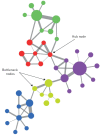From systems biology to P4 medicine: applications in respiratory medicine
- PMID: 29436404
- PMCID: PMC9489012
- DOI: 10.1183/16000617.0110-2017
From systems biology to P4 medicine: applications in respiratory medicine
Abstract
Human health and disease are emergent properties of a complex, nonlinear, dynamic multilevel biological system: the human body. Systems biology is a comprehensive research strategy that has the potential to understand these emergent properties holistically. It stems from advancements in medical diagnostics, "omics" data and bioinformatic computing power. It paves the way forward towards "P4 medicine" (predictive, preventive, personalised and participatory), which seeks to better intervene preventively to preserve health or therapeutically to cure diseases. In this review, we: 1) discuss the principles of systems biology; 2) elaborate on how P4 medicine has the potential to shift healthcare from reactive medicine (treatment of illness) to predict and prevent illness, in a revolution that will be personalised in nature, probabilistic in essence and participatory driven; 3) review the current state of the art of network (systems) medicine in three prevalent respiratory diseases (chronic obstructive pulmonary disease, asthma and lung cancer); and 4) outline current challenges and future goals in the field.
Copyright ©ERS 2018.
Conflict of interest statement
Conflict of interest: None declared.
Figures



Comment in
- doi: 10.1183/16000617.0088-2017
References
-
- Agusti A, Celli B, Faner R. What does endotyping mean for treatment in chronic obstructive pulmonary disease? Lancet 2017; 390: 980–987. - PubMed
-
- Auffray C, Sagner M, Abdelhak S, et al. . Viva Europa, a land of excellence in research and innovation for health and wellbeing. Prog Prev Med 2017; 2: e006.
-
- Macklem PT. Emergent phenomena and the secrets of life. J Appl Physiol 2008; 104: 1844–1846. - PubMed
Publication types
MeSH terms
LinkOut - more resources
Full Text Sources
Other Literature Sources
